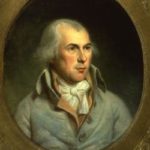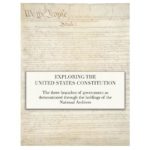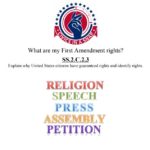In this lesson, students explore the scope and limits of the establishment clause of the First Amendment. First, students read and discuss an article on the constitutional issue of student-led prayer at public school events. Next, they role-play Supreme Court justices and attorneys deciding this issue. Finally, in a whole-class discussion, they debrief their own findings and compare them with those of the Supreme Court in the case of Santa Fe Independent School District v. Jane Doe et al.
Freedom of Religion: Establishment Clause
The First Amendment has two clauses related to religion: one preventing the government establishment of religion (the establishment clause) and the other protecting the ability to freely exercise religious beliefs (the free exercise clause). Students examine the First Amendment’s Establishment Clause: why it was included in the Bill of Rights, the issues it addresses, and how the Supreme Court has interpreted it over time.
Free Speech Essentials
Do your students know what they’re free to say online? At school? On a public street corner? From censorship to cyberbullying, the First Amendment and the freedoms it protects are as hotly contested as ever. This EDCollection explores 16 free speech debates ranging from the founding of our nation to recent headlines to illustrate what free speech actually means, where it comes from, and how far it can go. Whether you’re a social studies teacher looking for a complete unit or an English teacher looking to spend a single class period on free expression, there’s something for everyone. Free registration required.
Government Speech Under the First Amendment
This lesson teaches students, through a simulation related to government-sponsored Confederate monuments, about the government-speech doctrine under the First Amendment. In particular, this lesson aims to (1) introduce students to the issue of government speech; (2) teach the doctrine; (3) apply the doctrine in a contemporary context; and (4) critically analyze the doctrine.
Engel v. Vitale (1962)
Does the recitation of a prayer in public schools violate the Establishment Clause of the First Amendment? A Jewish student sued a New York school board over the daily recitation of a prayer. Middle school level also available.
What are my First Amendment Rights? A Lesson for Early Elementary
James Madison and the First Amendment

This short video traces the evolution of Madison’s attitude towards the religious liberty guarantees of the First Amendment. Initially opposed to a Bill of Rights as both inappropriate and dangerous, Madison’s views changed as a result of political and philosophical considerations. Professor Jeffry Morrison emphasizes Madison’s belief that religion should play a vital but informal role in the life of the republic.
Elk Grove v. Newdow (2004)
Does a public school policy requiring teachers to lead willing students in reciting the Pledge of Allegiance violate the Establishment Clause? This case summary shows how the Supreme Court answered that question in 2004.
The Pursuit of Justice
The Pursuit of Justice book, written by Kermit L. Hall and John J. Patrick, analyzes 30 Supreme Court cases chosen by a group of Supreme Court justices and leading civics educators as the most important for American citizens to understand. An additional 100 significant cases included in state history and civics standards are summarized. The complete book or individuals chapters can be downloaded.
Exploring the United States Constitution eBook

Each chapter connects one or more of the billions of primary source documents in the holdings of the National Archives to the principles found in the United States Constitution. These documents exemplify the workings of the three branches of the federal government as laid out in our Constitution. This eBook is available as a Multi-Touch book for iPad and Mac on iTunes, or for PC, Android devices, Mac, iPhone, iPad, or eReader with Scribd.
